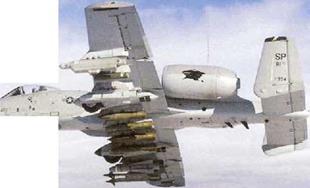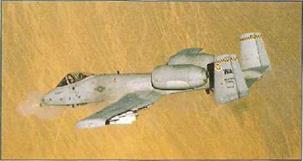Fairchild A-10 Thunderbolt

|
O |
riginally conceived as a counter-insurgency aircraft for the Vietnam War, the Fairchild A-10A Thunderbolt II emerged in 1972 as a dedicated dose air support aircraft, with a primary anti-armour role. The А-10’s operating environment dictated a highly-survivable design incorporating a ‘arge-area wing for excellent low-altitude manoeuvrability, rear-mounted engines shrouded from ground fire by either the wings or tailplane and redundant, armoured and duplicated flight controls and hydraulic systems. Titanium ‘bathtubs’ protect both the pilot and the ammunition tank.
The principal weapon is the AGM-65 Maverick anti-armour missile, supplemented by an enormous GAU-8/A 30-mm seven-barrelled rotary cannon. Avionics of the A-10 remained very basic for most of the aircraft’s career, with no laser designator or rangefinder fitted. The pilot has a HUD. and a screen for displaying images from Maverick or other EO-guided weapons. A Pave Penny marked target seeker detects and tracks targets designated by laser. Most current aircraft have received tne LASTE modification, which finally adds an autopilot and also improves gun accuracy.
The A-10 entered USAF service in 1977 At its peak deployment, a six A-10 squadrons were stationed in the UK, with more in Korea and the Continental USA. Debates raged as to the vulnerability of the A-10, and it was finally decided to gradually withdraw the type in favour of the F-16. At the
This A-10 of the Spangdahlem-based 81st FS is carrying a huge warload of Mk 82 bombs, Maverick missiles, Sidewinder AAMs and an ALQ-131 ECM pod.
same time, redundant A-10s became available to replace OV-1 Os in the forward air contro role. Unchanged, these were redesignatec ОА-ЮА and redistributed to tactical air support squadrons.
For the FAC role the A-10s are armed with rocket pods for marking targets and AIM-9 AAMs for self – defence. In xhe twilight of its career, the A-10 proved its worth during 1991 Desert Storm operations, destroying huge numbers of tanks, artillery pieces and vehicles. A modest upgrade programme is now underway, Lockheed Martin having won the contract in February 2001. The A-10 will receive a ‘precision engagement capability’ adding a new mission computer, new cockpit MFDs, a MIL STD 1760 databus, a new datalink, precision-weapons capability (including JDAM and WCMD), improved navigation equipment, TERPROM TRNS and new cefensive aids. A re-cngining programme nas been proposed, but not funded The A-10 has not been exported, although it is still possible that some 50 airframes may be sold to Turkey. The type is expected to remain in USAF service until 2028.
For its primary intended role as a tank killer on the Central European front, the A-10 was built around the massive CAU-8 30-mm cannon.
|

Ukratne/Russia










